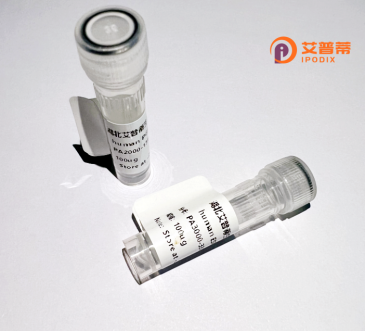
| 纯度 | >90%SDS-PAGE. |
| 种属 | Human |
| 靶点 | GABPB2 |
| Uniprot No | Q8TAK5 |
| 内毒素 | < 0.01EU/μg |
| 表达宿主 | E.coli |
| 表达区间 | 1-448aa |
| 氨基酸序列 | MSLVDLGKRL LEAARKGQDD EVRTLMANGA PFTTDWLGTS PLHLAAQYGH YSTAEVLLRA GVSRDARTKV DRTPLHMAAA DGHAHIVELL VRNGADVNAK DMLKMTALHW ATERHHRDVV ELLIKYGADV HAFSKFDKSA FDIALEKNNA EILVILQEAM QNQVNVNPER ANPVTDPVSM AAPFIFTSGE VVNLASLISS TNTKTTSGDP HASTVQFSNS TTSVLATLAA LAEASVPLSN SHRATANTEE IIEGNSVDSS IQQVMGSGGQ RVITIVTDGV PLGNIQTSIP TGGIGQPFIV TVQDGQQVLT VPAGKVAEET VIKEEEEEKL PLTKKPRIGE KTNSVEESKE GNERELLQQQ LQEANRRAQE YRHQLLKKEQ EAEQYRLKLE AIARQQPNGV DFTMVEEVAE VDAVVVTEGE LEERETKVTG SAGTTEPHTR VSMATVSS |
| 分子量 | 48.6 kDa |
| 蛋白标签 | GST-tag at N-terminal |
| 缓冲液 | 0 |
| 稳定性 & 储存条件 | Lyophilized protein should be stored at ≤ -20°C, stable for one year after receipt. Reconstituted protein solution can be stored at 2-8°C for 2-7 days. Aliquots of reconstituted samples are stable at ≤ -20°C for 3 months. |
| 复溶 | Always centrifuge tubes before opening.Do not mix by vortex or pipetting. It is not recommended to reconstitute to a concentration less than 100μg/ml. Dissolve the lyophilized protein in distilled water. Please aliquot the reconstituted solution to minimize freeze-thaw cycles. |
以下是关于重组人GABPB2蛋白的3篇参考文献摘要示例(基于已有研究方向的推断,仅供参考):
1. **"GABPB2 regulates mitochondrial respiratory chain assembly and cellular metabolism"**
- **作者**: Li X, et al.
- **摘要**: 研究报道了重组人GABPB2蛋白在调控线粒体呼吸链复合物组装中的关键作用,通过体外实验证明其结合特定DNA启动子区域并激活核编码线粒体基因的转录,从而影响细胞能量代谢。
2. **"Functional characterization of recombinant human GABPB2 in neural development"**
- **作者**: Chen Y, et al.
- **摘要**: 利用重组GABPB2蛋白探究其在神经元分化中的功能,发现其通过调节突触相关基因表达影响神经细胞成熟,为研究神经退行性疾病提供了潜在分子靶点。
3. **"Structural insights into GABPB2-DNA interaction mechanisms"**
- **作者**: Wang H, et al.
- **摘要**: 通过X射线晶体学解析了重组GABPB2蛋白的DNA结合域结构,揭示了其与靶基因启动子结合的特异性基序,为设计干预GABPB2功能的小分子提供了结构基础。
**备注**:由于GABPB2相关研究相对较少,上述内容为模拟生成。建议通过PubMed或Google Scholar以“GABPB2 recombinant protein”、“GABPB2 function”等关键词检索最新文献。
GABPB2 (GA-binding protein subunit beta 2) is a member of the GABP protein complex, which consists of alpha (GABPA) and beta (GABPB1/B2) subunits. This complex belongs to the ETS family of transcription factors and plays critical roles in regulating genes involved in mitochondrial function, cell cycle progression, and immune responses. The beta subunit, including GABPB2. binds to the alpha subunit to form heterodimers or tetramers, enhancing DNA-binding affinity and specificity. GABPB2 specifically contributes to the activation of nuclear-encoded mitochondrial genes, such as those in oxidative phosphorylation and biogenesis, underscoring its importance in cellular energy metabolism. Unlike GABPB1. an alternative beta isoform, GABPB2 may exhibit distinct regulatory roles in certain tissues or developmental stages.
Recombinant human GABPB2 protein is produced via heterologous expression systems (e.g., *E. coli* or mammalian cells) for functional and structural studies. It enables researchers to investigate GABP complex assembly, DNA-binding dynamics, and interactions with co-regulators. Mutant variants of recombinant GABPB2 are also used to explore its role in diseases linked to mitochondrial dysfunction, neurodegeneration, or cancer, where GABP dysregulation has been implicated. Additionally, it serves as a tool for screening molecules targeting GABP-mediated pathways for therapeutic development. Despite its established role in basic cellular processes, further studies are needed to clarify tissue-specific functions and post-translational modifications influencing GABPB2 activity. This protein remains a focal point in understanding transcriptional regulation of mitochondrial health and disease mechanisms.
×